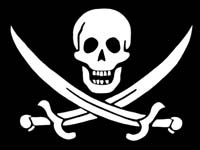《加勒比海盗》1(精讲之五)
[ 2007-04-11 18:59 ]

影片对白 Now
you see, Jack, that's exactly the attitude that lost you the Pearl. People are
easy to search when they're dead.
考考你
现学现卖
3. Make a stand
"Hold firm against something or someone 坚决反对/抵抗……,对……采取强硬立场"的意思,例如 The
government was determined to make a stand against all forms of terrorism.
4. With a will
意为"Vigorously, energetically",例如:He started working with a will.
文化面面观
Pirate flags
海盗的旗帜
 |
|
John Rackham
('Calico
Jack') | In popular legend, every pirate flag
displayed a skull above crossed bones or crossed swords. In fact there was ample
variation, since every crew wanted a unique flag. The first reference to a
modified basic 'Jolly Roger' was in 1700, when the French privateer Emmanuelle
Wynne flew a black flag embellished with a skull, crossed bones and an hourglass
(Henry Every flew a basic skull and crossed bones, though with the skull turned
to the side, as early as 1696, on both a red and black flag). It was presumably
also used before the turn of the century, although there is no surviving
evidence. It may also have indicated that the flyer no longer considered himself
to be a privateer, and was a full-blown pirate. What is known is that following
1700, additional emblems on the basic red or black flag were increasingly
associated with piracy, and different symbols were in turn associated with
individual pirate captains.
Of these, the most common symbol was the skull, the symbol of death. It was
also frequently depicted in association with crossed bones, another death symbol
(although only Edward England flew the "skull and crossed bones" in it's pure
form. Christopher Condent's banner repeated the same symbol 3 times.) Both signs
were commonly 'momento mori' on 16th and 17th century gravestones all over the
British Isles. Other symbols were complete skeletons, spears, swords,
hourglasses, initials, hearts, crossed swords, wings and raised glasses. In an
era where symbolism in art and everyday life was commonplace, each had a
distinct and immediately recognizable meaning. Apart from the death association
with bones, skeletons and skulls, dancing skeletons meant dancing a jig with
death, a fatalistic reference the flyer didn't care about his fate. This was
also the origin of the raised glass symbol ('toasting death'). Weapons were a
portent of slaughter to come, while hourglasses and wings indicated that time
was running out (or flying away). All these symbols can be found in contemporary
allegorical paintings of death, or on gravestones.
|